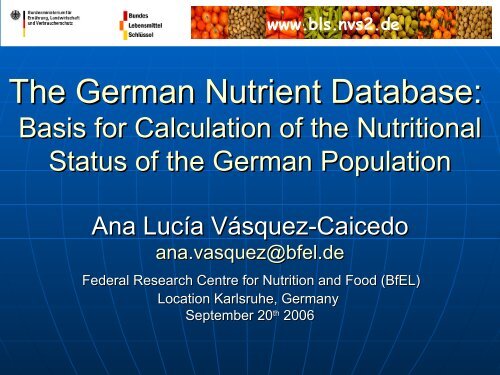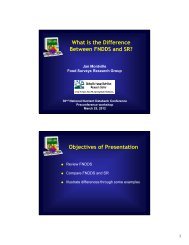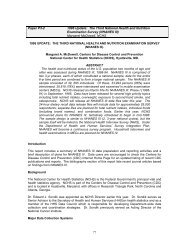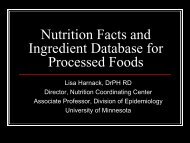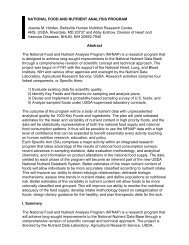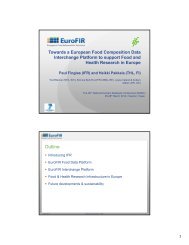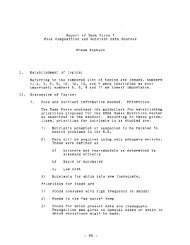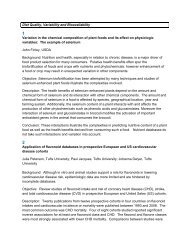The German Nutrient Database - National Nutrient Databank ...
The German Nutrient Database - National Nutrient Databank ...
The German Nutrient Database - National Nutrient Databank ...
You also want an ePaper? Increase the reach of your titles
YUMPU automatically turns print PDFs into web optimized ePapers that Google loves.
www.bls.nvs2.de<br />
<strong>The</strong> <strong>German</strong> <strong>Nutrient</strong> <strong>Database</strong>:<br />
Basis for Calculation of the Nutritional<br />
Status of the <strong>German</strong> Population<br />
Ana Lucía Vásquez-Caicedo<br />
ana.vasquez@bfel.de<br />
Federal Research Centre for Nutrition and Food (BfEL)<br />
Location Karlsruhe, <strong>German</strong>y<br />
September 20 th 2006
<strong>German</strong> <strong>Nutrient</strong> <strong>Database</strong> (BLS)<br />
Awarding authority: Federal Ministry of Food,<br />
Agriculture and Consumer<br />
Protection (BMELV)<br />
Executing Federal Research Centre for<br />
organization: Nutrition and Food (BfEL),<br />
location Karlsruhe<br />
Team: Bernd Hartmann<br />
Ana Lucía Vásquez-Caicedo<br />
Simone Bell
What is the BLS?<br />
� BLS (<strong>German</strong>: Bundes undeslebensmittel<br />
ebensmittelschlüssel) chlüssel)<br />
� Standard instrument developed for nutritional<br />
surveys in <strong>German</strong>y<br />
� Average nutritional values (133 constituents)<br />
� Approx. 10,000 foods available on the <strong>German</strong><br />
market<br />
� Fresh foods, food preparations and recipes
1 st digit<br />
2 nd digit<br />
3 rd and<br />
4 th digits<br />
5 th digit<br />
6 th digit<br />
7 th digit<br />
BLS Structure & Coding System<br />
F1<br />
Pomes<br />
F2122<br />
Sour cherry<br />
deep frozen<br />
F2<br />
Stone fruits<br />
F211<br />
Sweet cherry<br />
Industrial processing<br />
F2126<br />
Sour cherry<br />
juice<br />
F<br />
Fruit<br />
F3<br />
Berries<br />
F212<br />
Sour cherry<br />
F2129<br />
Sour cherry<br />
canned<br />
F212902<br />
Sour cherry canned, drained<br />
F4<br />
Wild fruits<br />
F5<br />
Tropical fruits<br />
Household preparation<br />
F212121<br />
Sour cherry<br />
cooked
LAB X<br />
LAB Y<br />
LAB Z<br />
Food Composition Table X<br />
Food Item<br />
BLS Generation<br />
326 11.70 5 3<br />
Apple, fresh Apple, fresh<br />
Wholemeal<br />
bread + linseed<br />
(Lab X)<br />
6800<br />
( Lab X)<br />
Components in mg/100g<br />
Protein Vitamin C Magnesium Methionin<br />
e<br />
(Lab Y)<br />
0.089<br />
(Lab Z)<br />
(Lab Z)<br />
53<br />
( Lab X)<br />
( Lab X)<br />
k.A.<br />
Food item<br />
Wholemeal<br />
bread + linseed<br />
Cherry tomato Data not available Cherry tomato<br />
Carrot, cooked Data not available Carrot, cooked<br />
• Mixed calculation<br />
• Derivated values<br />
• Yield and nutrient<br />
retention calculation<br />
Food Composition Table Y<br />
Tomato, red<br />
Carrot, raw<br />
BLS<br />
Components in mg/100g<br />
Protein Vitamin C Magnesium Methionin<br />
e<br />
326 11.7 5 3<br />
6751 0.091 58 99<br />
950 24.5 13 6<br />
952 4.5 12 10
<strong>The</strong> <strong>German</strong> <strong>National</strong> Nutrition<br />
Survey (NVS II)<br />
General objective representative data on food<br />
consumption, nutrition<br />
behaviour, energy and<br />
nutrient intake of the<br />
<strong>German</strong> population<br />
Structural objective linking to other surveys<br />
Methodological objectives improve existing methods,<br />
develop innovative methods<br />
Conceptual objectives implement nutrition<br />
monitoring, <strong>German</strong> <strong>Nutrient</strong><br />
<strong>Database</strong>
� 500 Sample Points<br />
� 4 waves (each 3 months)<br />
� 20,000 participants 14-80 years<br />
� Field phase: 13 months<br />
from Nov. 3 rd 2005 to Nov. 30 th<br />
2006<br />
th 2006<br />
Source: TNS Healthcare. Munich
Methods overview<br />
2. Computer assisted personal interview and<br />
questionnaire<br />
3. Anthropometric measurements<br />
4. Dietary history interviews (DISHES 05)<br />
5. 24-hour recalls (EPIC-SOFT)<br />
6. Dietary weighing records
NVS II BLS<br />
� BLS food composition database<br />
for the <strong>National</strong> Nutrition Survey II<br />
(NVS II)<br />
� NVS II provides BLS with<br />
representative view on <strong>German</strong><br />
eating habits<br />
� Improvement of BLS at run-time of<br />
NVS II (food choice, portion size<br />
and recipes)
Dietary history interviews (DISHES 05)<br />
� Software to collect information on habitual food<br />
intake of the past 4 weeks<br />
� BLS is integrated in the programme<br />
� Provides information about the most often<br />
consumed foods and beverages
24-hour recalls (EPIC-SOFT)<br />
� Detailed description of food intake in facets<br />
� Must be linked with BLS after data collection<br />
� Qualitative information for the update of the BLS<br />
database, new food items
Dietary weighing records<br />
� Twice 4 days: all eaten foods are weighed<br />
Beispielprotokoll NVS II<br />
Uhrzeit<br />
Ort<br />
7:30 zu Hause<br />
Lebensmittel und Getränke<br />
(Produktbezeichnung, Markenname (ggf.<br />
Discounter z. B. Aldi), Fettgehalt,<br />
Vitaminzusätze etc.)<br />
Weizen-Roggen-Mischbrot mit<br />
Sonnenblumenkernen<br />
Wochentag:<br />
Mo Di Mi Do Fr Sa So<br />
(bitte ankreuzen)<br />
Verpackung<br />
bei<br />
Einkauf<br />
Zustand<br />
bei<br />
Einkauf*<br />
Zubereitungsverfahren<br />
Datum:<br />
20.12.2005<br />
kg, g, mg bzw. L, mL<br />
Ver-<br />
zehrsfertige<br />
Menge<br />
lose frisch ____ 112 g<br />
Halbfettbutter „Du darfst“ P + M gekühlt ____ 42 g<br />
Erdbeermarmelade, selbst gemacht ___ ____ ____ 65 g<br />
Kaffee (Filterkaffee), „Jacobs“ M<br />
H-Milch, 3,5 % Fett, „Milbona“ T<br />
getrocknetultrahocherhitzt<br />
____ 254 g<br />
____ 84 g<br />
Restmenge/<br />
Abfall**<br />
10:15 im Büro Apfel, Jona gold U frisch ____ 220 g 23 g A<br />
� Must be linked with BLS after data collection<br />
� Provides currently used portion sizes and<br />
recipes
BLS development<br />
� Compilation of coherent nutrient data according<br />
to our quality system<br />
� Data transparency through documentation<br />
� Development of flexible data structures (coding)<br />
� Application of state of the art software solutions<br />
� Cooperation with nutrient data networks
BLS within the Federal Research<br />
Centre for Nutrition and Food (BfEL)<br />
Centre for Meat Research<br />
Weight Yield<br />
Centre for Cereal, Potato<br />
and Lipid Research<br />
Centre for Nutrition, Fruit<br />
and Vegetable Research<br />
Karlsruhe<br />
Kulmbach Kiel<br />
BLS<br />
Detmold/Münster<br />
BfEL<br />
Hamburg<br />
<strong>Nutrient</strong> Retention<br />
Dairy Research Centre<br />
Section for Fish Quality
Food Item<br />
Sample<br />
Scientific<br />
literature<br />
Cooperation<br />
partners<br />
Lab<br />
analyses<br />
Food<br />
industry<br />
International<br />
databases<br />
BLS update<br />
Scientific feedback<br />
<strong>Nutrient</strong><br />
retention<br />
factors<br />
Data<br />
compilation<br />
& evaluation<br />
Weight<br />
yield<br />
Data<br />
processing<br />
Portion<br />
size<br />
BLS<br />
Generation<br />
& Metadata<br />
BLS Online<br />
Computing and cooperation platform<br />
Applied research feedback<br />
Evaluation of<br />
nutritional surveys<br />
with the BLS<br />
BLS-Online<br />
access<br />
BLS Users
BLS Online Computing &<br />
Cooperation Platform
BLS online: www.bls.nvs2.de
Food<br />
Industry<br />
Private<br />
Laboratories<br />
BLS Networking<br />
BLS<br />
NVS II<br />
EuroFIR<br />
BfEL<br />
<strong>The</strong> BLS is open for new<br />
cooperation partners<br />
State Department<br />
of Food Control &<br />
Analysis<br />
<strong>National</strong><br />
Research<br />
Institutes
EuroFIR<br />
� Integrate European expertise and resources in<br />
food composition database systems<br />
� Harmonization<br />
• Food identification (LanguaL)<br />
• Standards development<br />
� Component coverage, definition & documentation<br />
� <strong>Nutrient</strong> retention factors<br />
� Recipe calculation, etc. etc<br />
• Quality system
� BLS II.4: 2007<br />
• BLS optimization for the <strong>German</strong> <strong>National</strong><br />
Nutrition Survey<br />
� BLS III: 2009<br />
Plans for the future<br />
• Completely new revised BLS edition<br />
• Optimization of the BLS cooperation<br />
platform with other European database<br />
systems (EuroFIR) as well as other<br />
national and international networks
BLS & NVS II Teams
Special thanks to:<br />
• <strong>The</strong> Federal Ministry of Food, Agriculture and<br />
Consumer Protection, for financing the BLS research<br />
activities (www.bmelv.de<br />
( www.bmelv.de)<br />
• EuroFIR, for financing our participation at the 30 th US<br />
<strong>National</strong> <strong>Nutrient</strong> <strong>Databank</strong> Conference<br />
(www.eurofir.net<br />
www.eurofir.net)<br />
• NVS II Team, specially to Christine Brombach, Project<br />
manager, and Carolin Krems, for their valuable input<br />
to this presentation (www.was-esse-ich.de,<br />
( www.was-esse-ich.de,<br />
nvs.karlsruhe@bfel.de)<br />
nvs.karlsruhe@bfel.de


